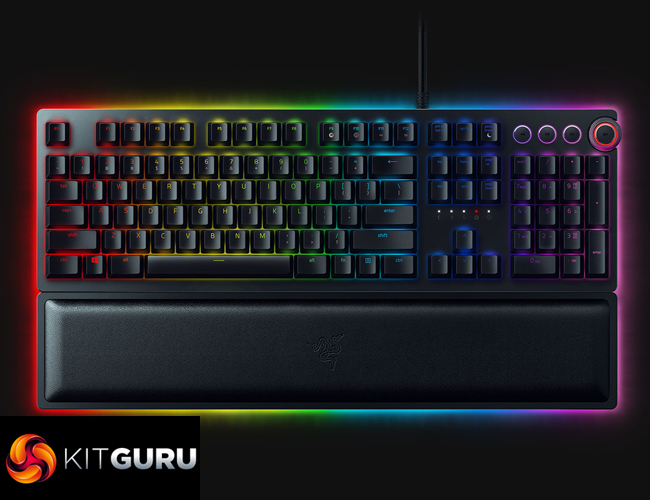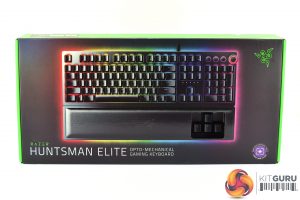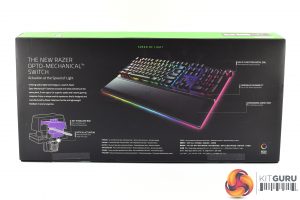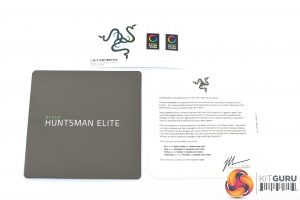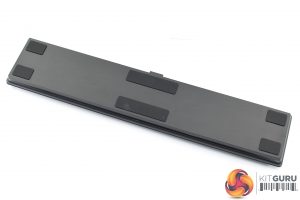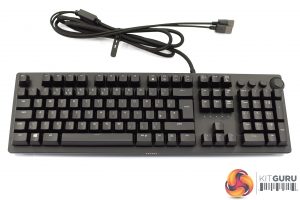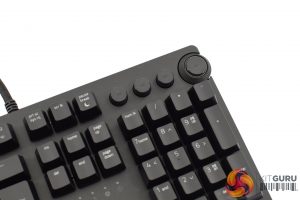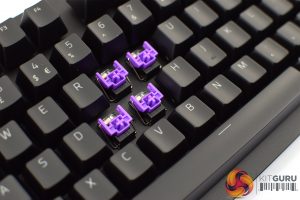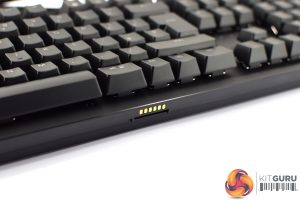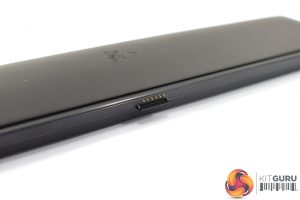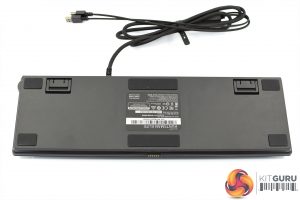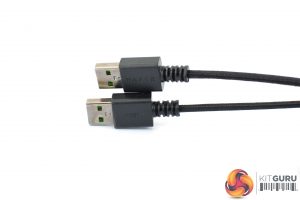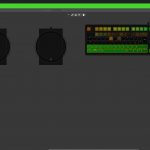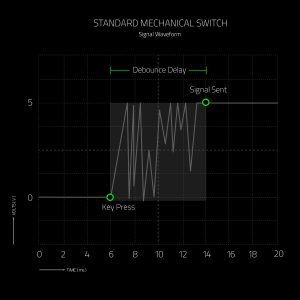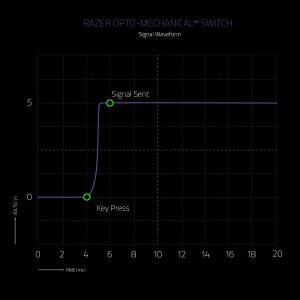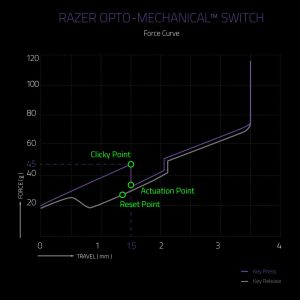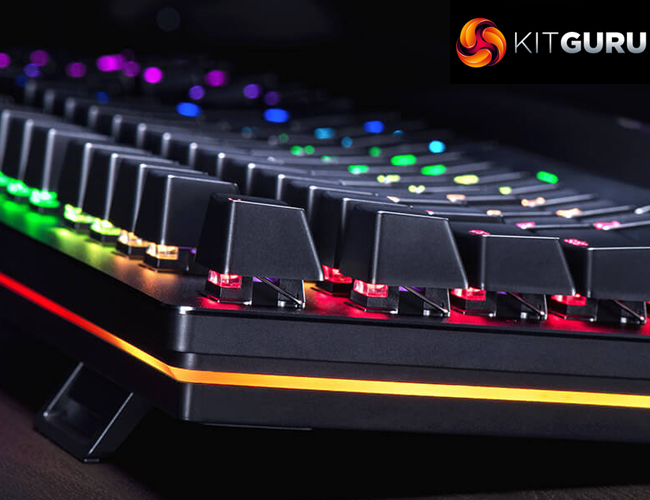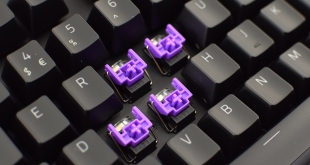
It's been a while since we last saw a new keyboard from Razer – but the wait is over, as today we are reviewing the £200 Huntsman Elite. This keyboard boasts an aluminium top-plate, new dedicated multimedia keys, as well as Opto-Mechanical switches. It is the latter feature which is most interesting, as we are now seeing optical switches being used by a major player in the peripheral market for the first time. Just how do they work, and what is the benefit? Let's find out.
On top of the features outlined above, the Razer Huntsman Elite has a few new tricks tucked up its sleeve. One is the Chroma-enabled RGB wrist-rest that attaches to the keyboard magnetically, while the Huntsman Elite is also the first Razer keyboard to include on-board profiles. Priced at £199.99 direct from the Razer Store, however, this is as pricey a gaming keyboard as they come. Let's see if it is worth it.
Specification:
- Razer Opto-Mechanical™ Switch with 45 G actuation force
- 100 million keystroke lifespan
- Razer Chroma backlighting with 16.8 million customizable color options
- Underglow lighting with 38 customization zones
- Ergonomic Wrist Rest with 24 customization zones underglow
- Multi-Function Digital Dial
- Dedicated media controls
- Hybrid On-board and Cloud Storage – Up to 5 Profiles
- Razer Synapse 3 enabled
- Fully programmable keys with on-the-fly macro recording
- 10 key rollover with anti-ghosting
- Gaming mode option
- Braided fiber cable
- 1000 Hz Ultrapolling
- Aluminum matte top plate
The Razer Huntsman Elite ships in a box that will be instantly familiar to those with other Razer products – it is black with green edges, and a large product photo dominates the front.
On the back, Razer dedicates a large chunk of space to the new Opto-Mechanical switch, while it also points out other key features of the keyboard itself.
In terms of documentation, we find 1x user guide, 1x welcome leaflet and 3x stickers.
Also included in the box is the detachable wrist-rest. This is a large, padded rest that is covered with faux-leather and sports a subtle Razer logo in the middle. The underside is also home to six anti-slip rubber feet.
Now, coming to the keyboard itself, on the face of it the Huntsman Elite looks pretty conventional. It is a full-size board, with a stealthy all-black aesthetic and a floating keycap design. Compared to the BlackWidow Chroma V2 it looks more square, and dare I say more professional, with a thinner frame and no Razer logo on the front.
The Huntsman Elite also sports a new aluminium top-plate which is something that has been missing from previous Razer keyboards I have reviewed. It's matte black anodised aluminium, though the rest of the keyboard is still made from plastic.
Speaking of things that have been missing from previous Razer keyboards, the top-right corner of the Huntsman Elite is home to four multimedia controls. Alongside a play/pause button, there are also next track and previous track controls, as well as a dedicated volume wheel which has a mute button in its middle. Personally speaking, I use dedicated media keys wherever I can, so this is a feature I am glad to see – even if it has been a long time coming.
Lifting off the keycaps reveals the Opto-Mechanical switches. These are purple in colour and sport regular Cherry MX stems, so you could easily replace the keycaps if you desire. It is also interesting to note that every switch is stabilised, something Razer says helps gives a more balanced feel while typing. Most keyboards with Cherry switches, for instance, only have stabilisers on the larger keys like the spacebar and enter key.
Elsewhere, positioned in the middle of the keyboard's front edge, we find six little gold contact points. This is actually where the wrist-rest connects to the keyboard, via its own set of pogo pins. This allows the wrist-rest to receive power from the keyboard itself, which it uses for its RGB lighting – but more of that on the next page.
It is worth pointing out before moving on, however, that Razer says it can utilise this pogo pin connector to make other accessories for the Huntsman Elite – including a charging pad, some kind of trackpad, or a phone dock. We are yet to see any development of this idea further, but it could be one way of adding extra value to the purchase of a Huntsman Elite.
Flipping the keyboard over reveals another set of six anti-slip rubber feet as well as the flip-out stand for raising the height of the board. Incidentally, the flip-out stand can actually be set to two different heights, so you can choose which angle you prefer.
Lastly, the Huntsman Elite requires two USB ports – one for the keyboard itself, and the other to power the wrist-rest lighting via the pogo pins. The braided cable itself is not detachable, measures approximately 2m and is quite thick.To test the Huntsman Elite, I used it as my primary keyboard for a couple of weeks – using it for both typing and gaming. We break our testing down into four main sections: software, lighting, build quality and comfort, and performance.
Software
Note: if the above images are not displaying properly, you may need to disable your ad block software as they are known to interfere with our display code.
The Huntsman Elite uses Razer Synapse 3.0 software. It is a free download from Razer's website, but it does require an account to use. Still, it is easy to navigate as everything is broken up into just two tabs – ‘customize' and ‘lighting'.
The customize tab lets you re-map the keyboard's buttons, configure the gaming mode and save/load profiles. Up to 5 profiles can be stored directly to the keyboard, but do note that any lighting effects can only be saved to the cloud.
Moving onto the lighting tab, here you can choose from a number of quick effects including ‘wave', ‘spectrum cycling' and ‘fire', the latter of which looks particularly good in my opinion. Or, if you are feeling adventurous, you can enter Chroma Studio and create your own effects and lighting patterns on a per-key basis.
All in the all, the software side of things is just fine. Synapse lets you re-map every button on the keyboard which is great for macro users, and you can configure the lighting as well. It's simple but effective.
Lighting
As for the lighting, I have to say this is one area where Razer knocks its rivals out of the park. Not only is the software control sophisticated enough to let you create complex patterns, but the variety of quick effects is impressive. More to the point, though, the LEDs themselves just look great – colours are bright, vibrant and they shine through they keycaps well.
With the wrist-rest attached, too, the lighting spreads the whole way round the board, which means the Huntsman Elite sports a total of 168 programmable LEDs. There's just no two ways about it – if you like your RGB lighting, the Huntsman Elite does it brilliantly.
Build quality and comfort
Moving onto build quality, I already mentioned on the previous page that the Huntsman Elite sports a new aluminium top-plate. This makes the keyboard feel generally pretty solid, and I also think it looks great. The underside of the keyboard is still made from plastic, so there is a little flex when pressure is applied, but overall build quality is certainly good.
One area of the build that I am not overly happy with, however, is the keycaps. They just feel quite thin and brittle – they feel like cheap caps, which is a shame considering this is a £200 keyboard. Some thick-walled PBT caps would've been the perfect complement to the Huntsman Elite.
In terms of comfort, I appreciate the fact that the height of the keyboard can be adjusted in two steps – so you can either have it raised a little, or raised even further. I went with it raised as far as it would go, but it is good to have the option.
The main thing that aids comfort, however, is the wrist-rest. This is padded with foam and covered by faux-leather, and it feels great for your wrists as you type or game. It's just so soft. I also appreciate the fact that it sports the exact same aluminium top-plate as the keyboard itself, so it looks like a seamless addition to the main body of the keyboard.
Performance
Now, let's talk about what we're all here for: the Opto-Mechanical switches. To give you a complete breakdown, Razer has developed what is an optical key switch that has mechanical properties (in this case, a tactile bump and a click), hence the name ‘Opto-Mechanical'.
Unlike regular mechanical switches – and you can read all about different mechanical switches in our definitive guide – which use metal contact points to send a signal that a key has been actuated, Razer's optical switch uses a laser beam which ‘passes through the switch stem when a key is pressed, which then actuates via a receiver that sends the corresponding signal to the computer.'
Credit: Razer
The benefit to this method is speed. This is because a traditional mechanical keyboard has to deal with something known as ‘contact bounce'. This is where a switch makes repeated contact with its metal contact once a key has been pressed, as it bounces up and down a few times due to the force applied. To counteract this, mechanical keyboards implement a delay (known as de-bounce) where any signals received within a set time-frame (usually 5ms but can be up to 20ms) are ignored as they are deemed to be sent as a result of contact bounce, rather than a deliberate key press.
Thus, when a Opto-Mechanical switch uses an infrared light beam to actuate – instead of using metal contact points that are prone to bouncing – the keyboard can eliminate the de-bounce time period altogether, which means a key press signal is sent faster.
So, that's the optical part of the switch – the mechanical element is in regards to the ‘feel' of each press. In short, these Opto-Mechanical switches are relatively light, clicky switches. They sport a 1.5mm actuation distance, with a force requirement of 45g to actuate. The click is very audible, and despite being of a slightly higher pitch than a Cherry MX Blue, for instance, total volume output is similar.
In practice, there's no denying the similarities between the Razer Purple Opto-Mechanical switch, and the Cherry MX Blue. Razer's switch is essentially the same thing, but lighter and faster. If you've always wanted a Cherry MX Blue that's better for gaming, here it is. There are a couple of differences, though. Primarily, the Opto-Mechanical switch clicks at the point of actuation, whereas the MX Blue clicks then actuates.
Credit: Razer
Opto-Mechanical switches also click, actuate and reset at almost the same point – meaning as you release the key after a press, you don't have to release nearly as much pressure on the key in order to press it again, as you would for a mechanical switch which has to be released further to allow the switch to be reset, and then actuated again. Essentially, this allows for faster rapid keypresses without the need to keep releasing the switch to a further reset point.
So, that is the technology behind the Opto-Mechanical switch. I personally love the feel of the switches – as I mentioned, they basically feel like faster and lighter Blues, but then you have the benefits of an optical switch on top of that.
The question is – is the benefit of an optical switch actually noticeable? Certainly, the switches are objectively faster as there is no de-bounce period and the reset point is closer to the point of actuation. I have to confess, however, I could not tell the difference in speed while gaming with the Huntsman Elite, versus using a Cherry MX Brown keyboard.
The switches are objectively faster – but if you can't tell, does it really matter? Or, does it not matter that you can't tell the difference because the switches are objectively faster? It's a bit of a conundrum.
Personally speaking, I would not be inclined to shell out £200 when I am not gaining a noticeable benefit over something with good old Cherry MX switches. If you take your gaming very seriously, however, you may want the absolute fastest thing out there – whether you can tell the difference or not.The Razer Huntsman Elite has been a tricky product to review.
On the one hand, it makes a number of improvements over the BlackWidow Chroma V2 – there is a new aluminium top-plate, we finally have dedicated media keys and the wrist-rest has integrated Chroma lighting.
The main feature of the keyboard is undoubtedly the Opto-Mechanical switch, though.
It is with these switches where my main difficulty lies – as I outlined on the previous page, these switches are objectively faster due to their optical nature. The problem lies in the fact that I simply couldn't tell the difference in speed between the Huntsman Elite and my trusty Cooler Master MasterKeys Pro S with MX Browns.
For me, that has made it hard to score – the Huntsman Elite comes with a high price, and while the hybrid switches are certainly an impressive feat of engineering, does it matter if you can't tell the difference? Well, maybe you will be able to tell the difference – but for me, I can't say the Opto-Mechanical switches have revolutionised how I play PC games.
The other thing to note is that there is no switch variety. With Cherry MX-based keyboards, most manufacturers offer you a choice of Reds, Blues, Browns and so on – meaning you can choose if you want a linear switch, a tactile switch, or a clicky switch. If you want an Opto-Mechanical switch, you have to get the Purple variant, which is tactile and clicky. If Razer can offer Opto-Mechanical versions of its Yellow and Orange switches, I think that would only help the appeal of the Huntsman Elite.
So, wrapping it up – should you buy the Razer Huntsman Elite. If you want the absolute fastest switches out there – go ahead. It will set you back a cool £199.99, but there is a lot to like – including new media keys and aluminium top-plate. Razer fanboys will also love the Chroma lighting.
If you are happy with your current keyboard, though, I can't say with certainty that you will notice the benefit of the Opto-Mechanical switches. And given the premium you pay for the keyboard, it is certainly a risk to find out.
You can buy the Huntsman Elite directly from Razer for £199.99 HERE.
Pros
- Opto-Mechanical switches feel great and are objectively faster than traditional mechanical switches.
- New aluminium top-plate.
- We finally have dedicated media keys on a Razer keyboard.
- Top-class RGB lighting.
- Wrist-rest is plush and very comfortable.
Cons
- I couldn't tell the difference in speed between an Opto-Mechanical and a Cherry MX Brown.
- Opto-Mechanical switches are currently only available in one style – tactile and clicky.
- Costs £200.
KitGuru says: The Huntsman Elite is undoubtedly a successful keyboard, and the Opto-Mechanical switches are undeniably impressive. It is not cheap, though, and you may not even notice the difference between these switches compared to your old Cherry MX board.
Be sure to check out our sponsors store EKWB here
 KitGuru KitGuru.net – Tech News | Hardware News | Hardware Reviews | IOS | Mobile | Gaming | Graphics Cards
KitGuru KitGuru.net – Tech News | Hardware News | Hardware Reviews | IOS | Mobile | Gaming | Graphics Cards


